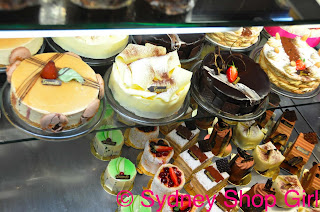After breakfast, we met Didier the owner of Ganache and his head pastry chef, Pascale.
I also met several beautiful cakes who were studiously ignoring me from behind their glass display cabinet.
And nearly asked for the phone numbers of a stack of coffee bowls and whether they were interested in coming around to my place for the weekend.
Didier started by speaking about the butter used in the pastry at Ganache. Due to the way the pastry is made, butter sheets as opposed to the blocks we all know and love are the more time efficient way for patisseries to buy their butter. In the photo below, the butter sheet is on the left and the dough is on the right.
Unfortunately, there are 2 things going against Australian butter – none of the producers here sell as commercially useful sheets and the fat content of our butter is a measly 67%. Across the ditch in New Zealand, butter is sold in sheets and also has a superior fat content of 88%. In the mother land, French butter has a fat content of 98 – 99%.
Live yeast is favoured. It keeps for about a month in the fridge.
While dry yeast will do for those times when you’re the head pastry chef on cruise liner at sea with no access to the fresh stuff.
Whichever form you may use, the secret to yeast is to not let it come into direct contact with salt or sugar as this will denature it.
This the the pastry maker that creates the fine layers of butter and dough. You can see why flat sheets of butter make the job so much easier.
Industrial sized mixer blades.
Marble work surfaces for rolling out the pastry. With a few deft folds, Didier transformed a few squares of buttery pastry dough into a croissant, a danish and a pan au chocolait.
The secret to a good chocolate pastry – bars of dark chocolate rolled inside the pastry so that the chocolate is evenly distributed and there are no bites of ‘just pastry’. Ganache make their own chocolate bar filling. It’s a dark chocolate.
We then moved on to Pascale’s cake decorating demonstration. As the above photo confirms, speed and accuracy is everything if you are to make it to the top as a pastry chef.
There are 2 best selling cakes at Ganache:
– the black and white cake which has a biscuit type base and chocolate mousses (plural!!) on top, white and dark
– the chocolate ganache cake which is based on a syrup soaked chocolate sponge (1 kilo of chocolate for every 1 litre of milk).
According to Didier (and I humbly agree), chocolate is the perfect all season flavour for cakes. It’s available all year round and its quality isn’t great affected by the weather.
Rows of choux pastry being baked for eclairs.
Step one in decorating the cake. A light coating of cream to help the chocoalate stick.
White chocolate melted in a bain marie is quickly spread on an ice cold but dry marble slabe to make thin chocoalte sheets for the side of the cake.
Cake decorating always looks so easy and neat when the professionals are involved.
As the chocolate cools and the marble slab warms up, it becomes easier to make the thicker folded curls for the top of the cake.
Pascale moves on to decorating the chocolate cakes with a ganache. Again, it is precise, perfect and tidy work.
The patisserie’s ovens continue their day and have now moved on from the eclairs to hearty pies and sausage rolls for the lunchtime crowd.
We talk about some of the tools of the trade in decorating cakes. Plastic is a great base for making all sorts of chocolate pieces. Bubble wrap allows for intersting rings to be created between the bubbles. Smooth, curved plastic sheets allow for spirals and curls to be fashioned from chocolate.
Precious metal coloured powders are also used to dust the cakes. They add a bit of sparkle that cocoa and icing sugar can’t. Each post of powder costs around $60.

I thought these cakes were pretty spectacularly decorated but apparently, these are considered at the more practical range of cake decorations that would be suitable for cakes sold in shops as opposed to what pastry chefs would serve in a restaurant setting. The all chocolate cakes travel better and keep better than some of the more elaborate cream and fruit based cakes.
It was hard to escape MasterChef and its influence on Australians from all walks of life. We couldn’t help but ask for opinions on what Gary and company advise about on the show. I have to admit, I have not been religiously watching but there were some hard core fans in our group with an encyclopaedic knowledge of each episode and the form of each contestant.
In a recurring theme of the day, the chefs that we visited all took the questions in good humour. Sometimes, they chose to just acknowledge the elephant in the room and mentioned MasterChef before anyone could ask any questions relating to it.

I remember these pastries from my school days. We used to be allowed one treat every so often from our local patisserie after school. These were my favourite. I called them butterflies.
After our tour, it was time to get back on the bus and cross the city again to head for our next destination. This photo was taken from the bus so apologies for the poor focus, think of it as an action shot.























